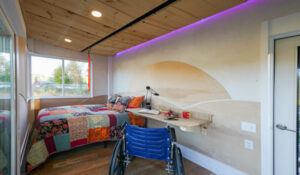24 Feb Tips for Redesigning a Bedroom to be More Accessible
 In the world of accessibility, the bedroom is one of your greatest considerations. After all, this is where you’ll spend most of your time after the sun goes down when you don’t have the advantage of natural light. There are many things to think about when redesigning a room with special needs in mind, including the size of the bed, location of your furniture, and even the height of your wheelchair, if applicable. If you have yet to outfit your room with the features that can make life easier, here are a few tips to get started.
In the world of accessibility, the bedroom is one of your greatest considerations. After all, this is where you’ll spend most of your time after the sun goes down when you don’t have the advantage of natural light. There are many things to think about when redesigning a room with special needs in mind, including the size of the bed, location of your furniture, and even the height of your wheelchair, if applicable. If you have yet to outfit your room with the features that can make life easier, here are a few tips to get started.
First, Plan Your Budget
If your home’s floor plan incorporates universal design, there might not be that much to do. However, if it’s not, you may have to remove or relocate walls, widen doorways, and change the flooring. And this can get pricey. A full bedroom remodel can cost upwards of $20,000, and if you have to change your bathroom, you can plan to spend about the same on that room, too.
Unless you’re one of the lucky few that has an extra $40,000 just sitting in the bank, you’ll need to figure out how to pay your remodeling costs. Your options include:
- Cash out refinance. A cash out refinance is essentially the process of taking out a new home mortgage. However, instead of financing just the home, your loan is a higher amount than what you currently owe, and your monthly mortgage payment will reflect this. The difference between what you owe and your total loan amount is converted into cash, which you can use for your remodeling endeavors. PennyMac notes that you’ll likely need at least 20 percent equity to qualify.
- HELOC. A HELOC is a home equity line of credit. Like a cash out refinance, you’ll have to have plenty of home equity. But instead of taking out a second mortgage, you can use this like a credit account, and you typically have 10 years to pay it back.
- Charitable organizations and Medicare. Depending on where you live, your disability, and your age, there might be local charities that can help cover the cost of some of your remodeling efforts. Further, you may be eligible for home improvement grants, and Medicare may cover some modifications that are medically necessary.
Bedroom Remodeling
When it’s finally time to plan your bedroom remodel, you should start with an empty room. You’ll need to know the dimensions as well as the size of the bed you have or plan to use. According to Accessible University, a 12-by-10 space is sufficient, but you may need more room if you have a larger bed. Next, look at the flooring. If there is a transition between one flooring type to another, it’s best to eliminate this potential obstacle. Low carpet or hardwood is the easiest to maneuver on if you are in a wheelchair. Entry doors should be at least 36 inches wide, and the same goes for the closet, particularly if it is a walk-in closet. To make clothing and accessories more accessible, these items should be located no more than 55 inches above the floor
Ideally, you’ll have minimal furniture and at least a five-by-five turning radius on both sides of the bed. The Handicap HomeMods blog also suggests ensuring that there are electrical outlets near the bed. These should be mounted higher than floor level so you can easily reach them.
Everyone deserves a safe place to lay their head at night. And if you have a disability, the safety of your bedroom is a top priority. Although the financial aspect of a remodel is frightening, take heart knowing that there are options.
Miriam Neal, Article Author
[email protected]



Sorry, the comment form is closed at this time.